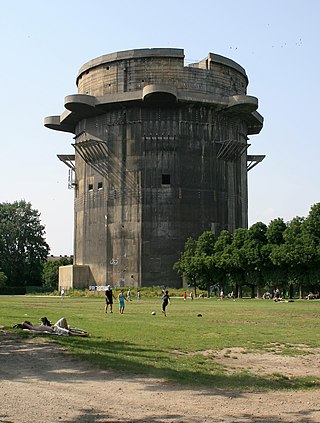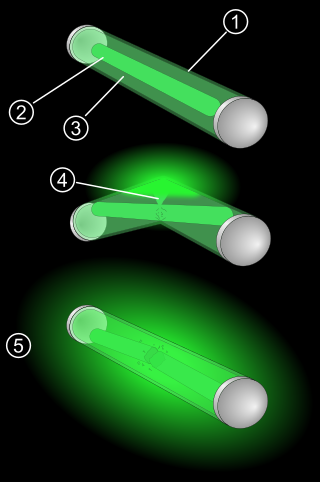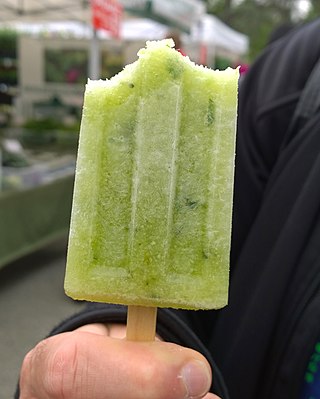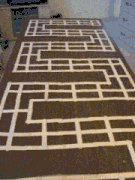
A boomerang is a thrown tool typically constructed with aerofoil sections and designed to spin about an axis perpendicular to the direction of its flight. A returning boomerang is designed to return to the thrower, while a non-returning boomerang is designed as a weapon to be thrown straight and is traditionally used by some Aboriginal Australians for hunting.

Hockey is a term used to denote a family of various types of both summer and winter team sports which originated on either an outdoor field, sheet of ice, or dry floor such as in a gymnasium. While these sports vary in specific rules, numbers of players, apparel, and playing surface, they share broad characteristics of two opposing teams using a stick to propel a ball or disk into a goal.

A loom is a device used to weave cloth and tapestry. The basic purpose of any loom is to hold the warp threads under tension to facilitate the interweaving of the weft threads. The precise shape of the loom and its mechanics may vary, but the basic function is the same.

Weaving is a method of textile production in which two distinct sets of yarns or threads are interlaced at right angles to form a fabric or cloth. Other methods are knitting, crocheting, felting, and braiding or plaiting. The longitudinal threads are called the warp and the lateral threads are the weft, woof, or filling. The method in which these threads are interwoven affects the characteristics of the cloth. Cloth is usually woven on a loom, a device that holds the warp threads in place while filling threads are woven through them. A fabric band that meets this definition of cloth can also be made using other methods, including tablet weaving, back strap loom, or other techniques that can be done without looms.
This timeline of clothing and textiles technology covers events relating to fiber and flexible woven material worn on the body. This includes the making, modification, usage, and knowledge of tools, machines, techniques, crafts, and manufacturing systems (technology).

A nest is a structure built for certain animals to hold eggs or young. Although nests are most closely associated with birds, members of all classes of vertebrates and some invertebrates construct nests. They may be composed of organic material such as twigs, grass, and leaves, or may be a simple depression in the ground, or a hole in a rock, tree, or building. Human-made materials, such as string, plastic, cloth, or paper, may also be used. Nests can be found in all types of habitat.

A bunker is a defensive military fortification designed to protect people and valued materials from falling bombs, artillery, or other attacks. Bunkers are almost always underground, in contrast to blockhouses which are mostly above ground. They were used extensively in World War I, World War II, and the Cold War for weapons facilities, command and control centers, and storage facilities. Bunkers can also be used as protection from tornadoes.

Sand art is the practice of modelling sand into an artistic form, such as sand brushing, sand sculpting, sand painting, or creating sand bottles. A sandcastle is a type of sand sculpture resembling a miniature building, often a castle. The drip castle variation uses wet sand that is dribbled down to form organic shapes before the sands dries.

Bubble gum is a type of chewing gum, designed to be inflated out of the mouth as a bubble.

A carpet is a textile floor covering typically consisting of an upper layer of pile attached to a backing. The pile was traditionally made from wool, but since the 20th century synthetic fibers such as polypropylene, nylon, or polyester have often been used, as these fibers are less expensive than wool. The pile usually consists of twisted tufts that are typically heat-treated to maintain their structure. The term carpet is often used in a similar context to the term rug, but rugs are typically considered to be smaller than a room and not attached to the floor.

A glow stick, also known as a light stick, chem light, light wand, light rod, and rave light, is a self-contained, short-term light-source. It consists of a translucent plastic tube containing isolated substances that, when combined, make light through chemiluminescence. The light cannot be turned off and can be used only once. The used tube is then thrown away. Glow sticks are often used for recreation, such as for events, camping, outdoor exploration, and concerts. Glow sticks are also used for light in military and emergency services applications. Industrial uses include marine, transportation, and mining.

A lollipop is a type of sugar candy usually consisting of hard candy mounted on a stick and intended for sucking or licking. Different informal terms are used in different places, including lolly, sucker, sticky-pop, etc. Lollipops are available in many flavors and shapes.

Wicker is not a material, but a method of weaving by which its products are also identified with this name. It is the oldest furniture making method known to history, dating as far back as 5,000 years ago. Wicker was first documented in ancient Egypt using pliable plant material, but in modern times it is made from any pliable, easily woven material. The word wicker or "wisker" is believed to be of Scandinavian origin: vika, which means "to fold" in Swedish, and vicker meaning willow. Wicker is traditionally made of material of plant origin, such as willow, rattan, reed, and bamboo, but synthetic fibers are now also used. Wicker is light yet sturdy, making it suitable for items that will be moved often like porch and patio furniture. Rushwork and wickerwork are terms used in England. A typical braiding pattern is called Wiener Geflecht, Viennese Braiding, as it was invented in 18th century Vienna and later most prominently used with the Thonet coffeehouse chair.

The textile industry is primarily concerned with the design, production and distribution of textiles: yarn, cloth and clothing. The raw material may be natural, or synthetic using products of the chemical industry.
A lacrosse stick or crosse is used to play the sport of lacrosse. Players use the lacrosse stick to handle the ball and to strike or "check" opposing players' sticks, causing them to drop the ball. The head of a lacrosse stick is roughly triangular in shape and is strung with loose netting that allows the ball to be caught, carried, passed, or shot.

Radio Stars were an English punk rock band formed in early 1977. They released two albums and had one UK Top 40 single.

An ice pop is a liquid-based frozen snack on a stick. Unlike ice cream or sorbet, which are whipped while freezing to prevent ice crystal formation, an ice pop is "quiescently" frozen—frozen while at rest—and becomes a solid block of ice. The stick is used as a handle to hold it. Without a stick, the frozen product would be a freezie.

Night Shades is the fourth and final studio album by Cobra Starship,released through Fueled by Ramen and Decaydance Records on August 29, 2011. The album is the follow-up of 2009's Hot Mess. The first single from the album, "You Make Me Feel...", features singer Sabi and was released on May 10, 2011. The full album was made available to stream for free on their Facebook page prior to its release.

Pogopalooza: The World Championships of pogo is an annual championship that brings together the world's top Extreme Pogo athletes for multiple days of competition, exhibition, and world record setting. Along with the competition, Pogopalooza also features the largest exposition of pogo stick companies, a Free Jump/Clinic area for people of all ages to try out an array of pogo sticks – classic to extreme, along with sponsorship activations and experiences associated with the event. The organizers of Pogopalooza refer to the event as "the largest pogo stick event on the planet." Started by YouTube personality Pogobat in 2004 in a parking lot in Lincoln, Nebraska, Pogopalooza entered its 18th year for 2022 and has grown to be the largest and most widely attended property associated with the sport of Extreme Pogo.

Miles City is a city in and the county seat of Custer County, Montana, United States. The population was 8,354 at the 2020 census.



















